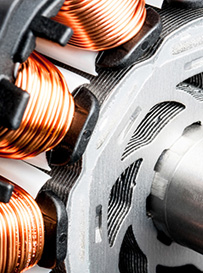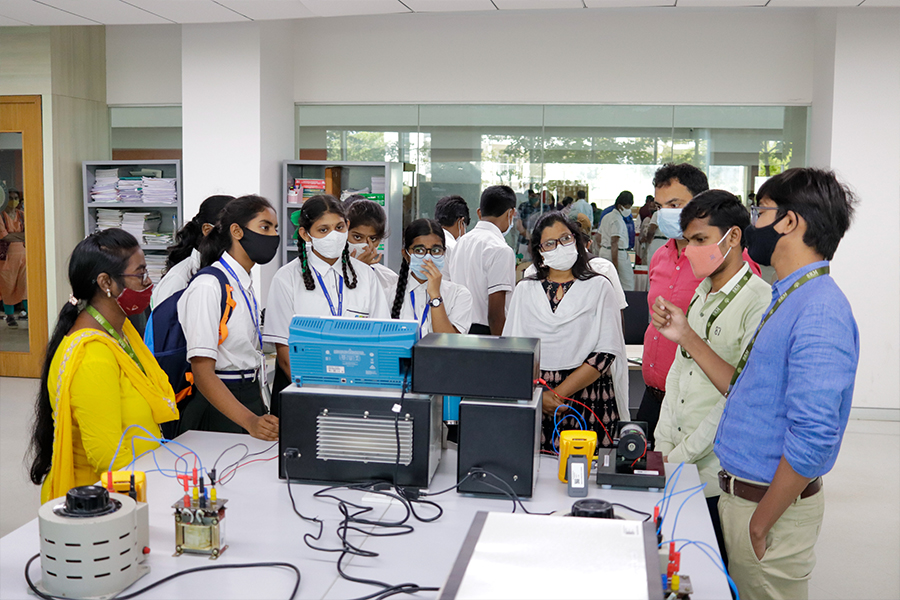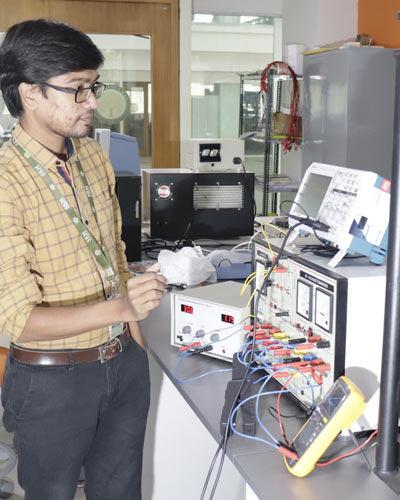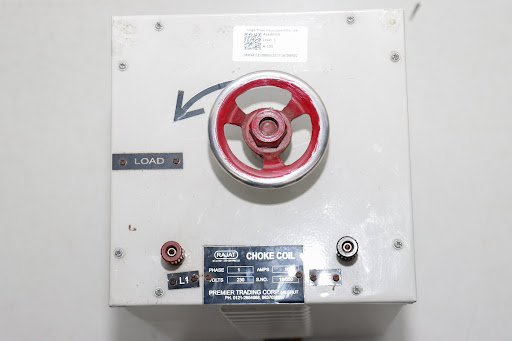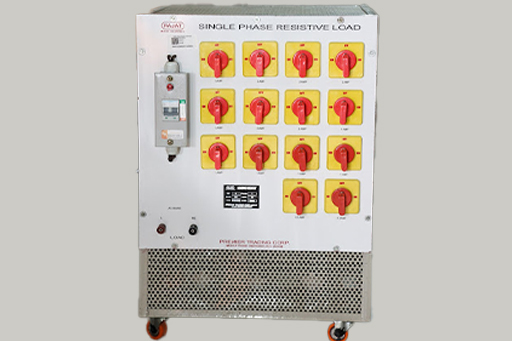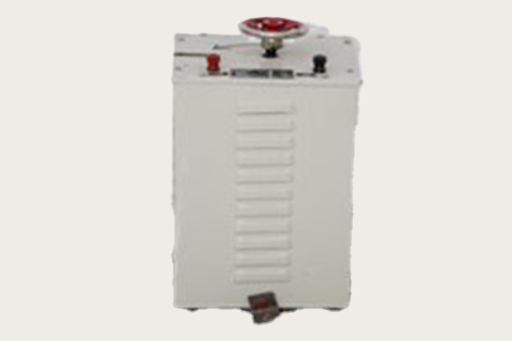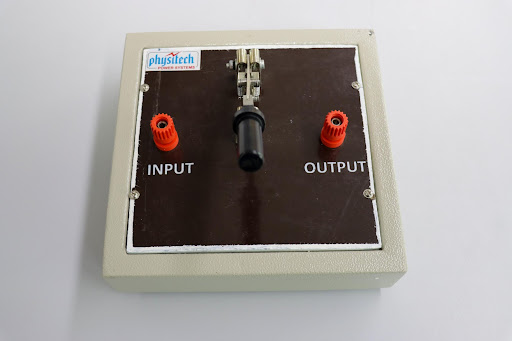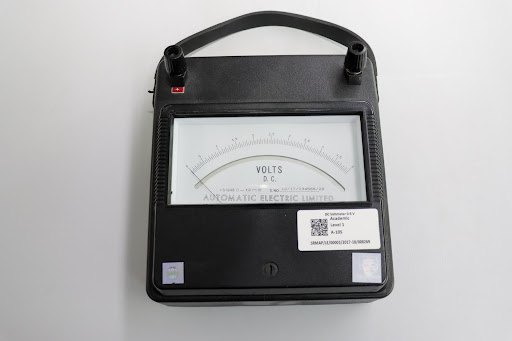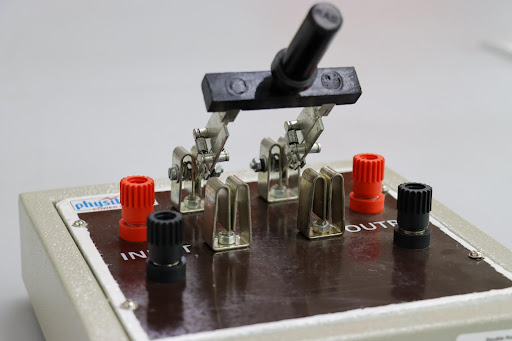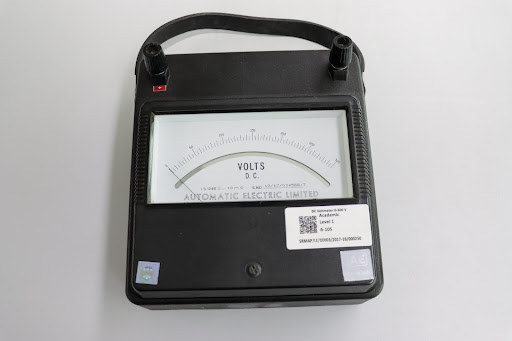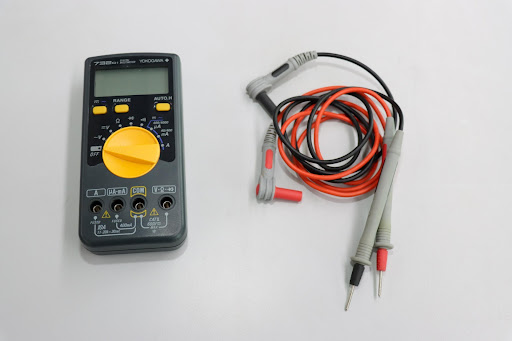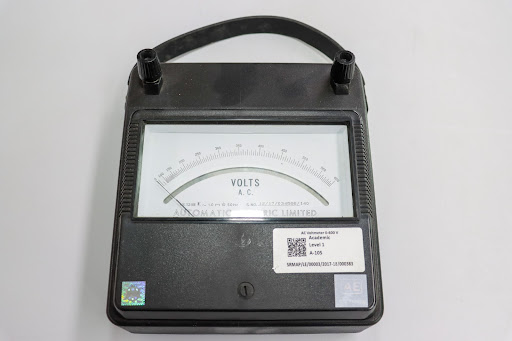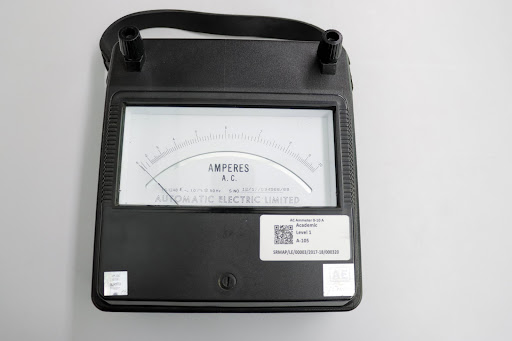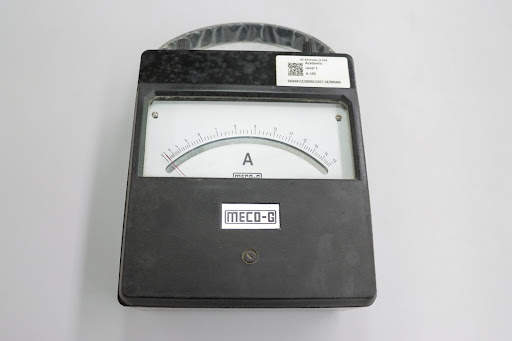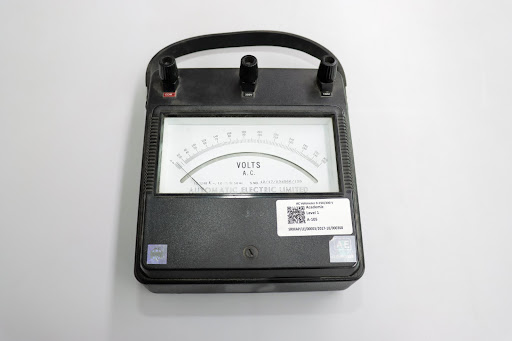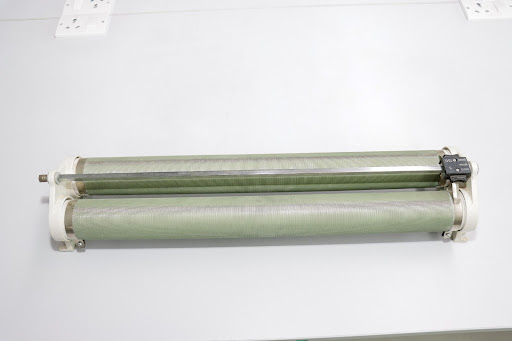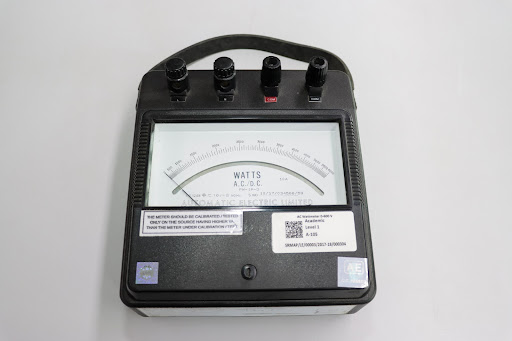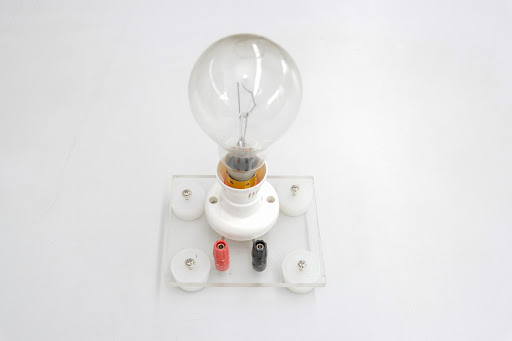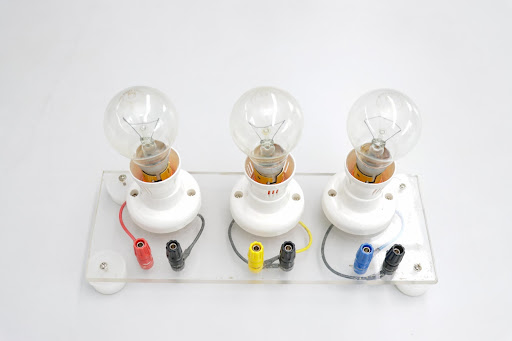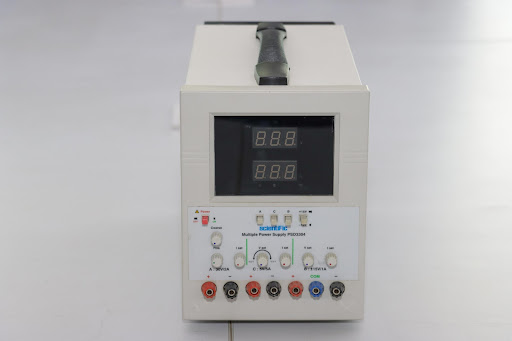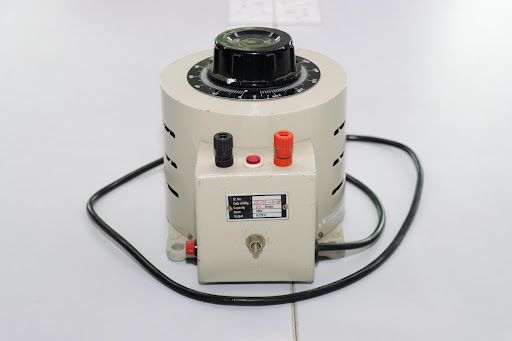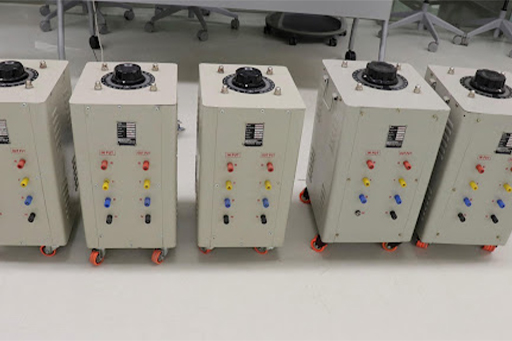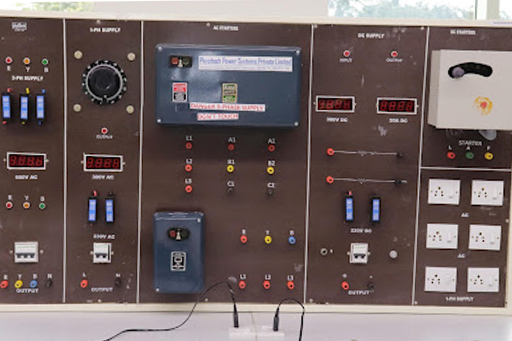SRM University-AP > Department of Electrical and Electronics > Laboratory Infrastructure

Basic Electrical Laboratory
- To verify Kirchhoff's laws.
- To verify Ohm's law laws.
- To verify Thevenin’s theorem.
- To verify Superposition theorem.
- To verify Reciprocity theorem.
- To verify Norton’s theorem.
- To verify Maximum Power transfer.
- To study the V-I characteristics of an incandescent lamp.
- Measurement of single-phase power by using three ammeter method.
- Measurement of single-phase power by using three voltmeter method.
- Measurement of three phase power by two-wattmeter method.
Description
In this experiment, the main aim is to verify Kirchhoff's voltage Law .
Kirchhoff’s Voltage Law states that the algebraic sum of the
voltages (or voltage drops) in any closed path of a network that
is transverse in a single direction is zero.
Components
- Ammeter (0-10A) MC type (3)
- Voltmeter (0-300V) MC Analog (1)
- Digital mutlimeter (1)
- Resistor 100 Ω (3)
- DC Regulated power supply (0-30V)
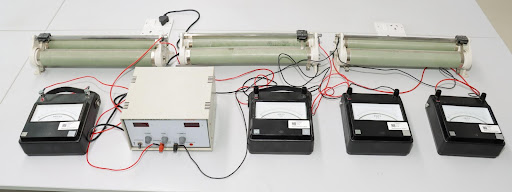
Description
In this experiment, the main aim is to verify Kirchhoff's current Law.
Kirchhoff’s current Law states that the algebraic sum of all the currents at any node point or a junction of a circuit is zero.
Components
- Ammeter (0-10A) MC type (3)
- Voltmeter (0-300V) MC Analog (1)
- Digital mutlimeter (1)
- Resistor 100 Ω (3)
- DC Regulated power supply (0-30V)
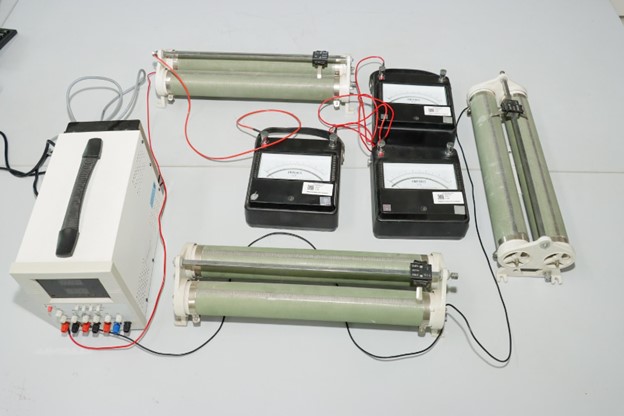
Description
In this experiment, the main aim to verify Ohm's law.
Ohm's law states that the current through a conductor between two points is directly proportional to the voltage across the two points.
Components
- Ammeter (0-10A) MC type (3)
- Voltmeter (0-300V) MC Analog (1)
- Digital mutlimeter (1)
- Resistor 100 Ω (3)
- DC Regulated power supply (0-30V)
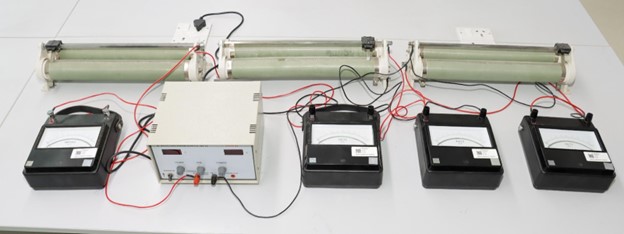
Description
This setup is designed to study the Thevenin’s, Norton’s, Superposition theorem.
Experiments
1. To study the Thevenin's Theorem & determine the values of VTH & RTH for the different values of Vi.
2. To study the Norton's Theorem & determine the values of Norton's Current IN & Norton's resistance RTH for the different values of Vi.
3. To study the Superposition Theorem & determine the values of Current & Voltage across R2 for the different values of V1 & V2.
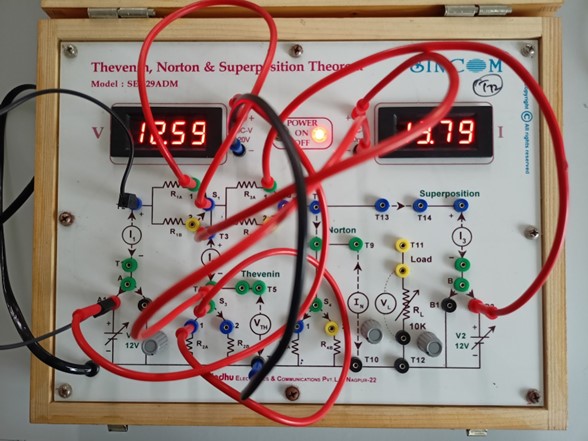
Description
This setup is designed to study the Maximum Power Transfer theorem, Reciprocity theorem & Superposition theorem.
Experiments
1. To study the maximum power transfer theorem & determine the value of current, voltage, source impedance & power delivered to resistive load for the differnt values of applied DC input Vi.
2. To study & verify Reciprocity Theorem.
3. To study & verify Superposition Theorem.
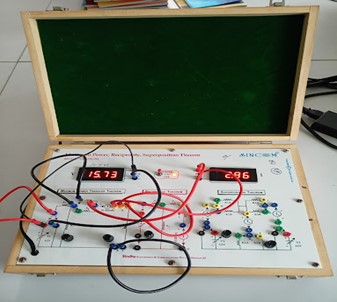
Description
In this experiment, the main aim is to study and plot the following V-I Characteristics of Tungsten Filament Lamp.
Components
- Ammeter (0-10A) MC type (1)
- Voltmeter (0-300V) MC Analog (3)
- Digital mutlimeter (1)
- Resistor 100 Ω (3)
- Variac (Single phase auto transformer (1)
- Lamp holder set
- Tungsten lamp
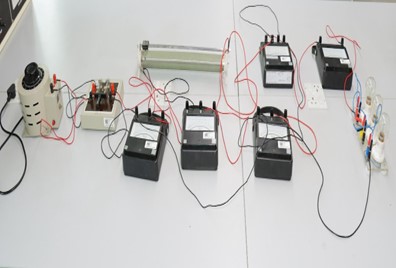
Description
In this experiment, the main aim is to measure single-phase power by using three ammeter method.
Components
- Ammeter (0-10A) MC type (3)
- Voltmeter (0-300V) MC Analog (1)
- Rheostat (1)
- 1-phase autotransformer (1)
- Inductive load 10 Amp (1)
The circuit diagram of measuring single phase power with the use of three ammeters is shown in the figure.
In this method, a non-inductive resistance R is connected across the inductive load with three ammeters arrangement. P = (l12-l22-l32) R/2.
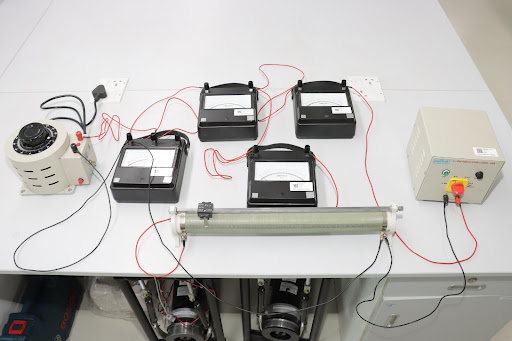
Description
In this experiment, the main aim is to measure single-phase power by using three voltmeter method.
Components
- Ammeter (0-10A) MC type (1)
- Voltmeter (0-300V) MC Analog (3)
- Rheostat (1)
- 1-phase autotransformer (1)
- Inductive load 10 Amp (1)
The power in a single-phase circuit can be measured using three voltmeters and the connection circuit for this method is shown in the figure.
Here the load is inductive, V1, V2 and V3 are voltmeters and R is a purely non-inductive resistance, which is connected in series with the circuit. Therefore, Power P = (V12-V22-V32)/2R.
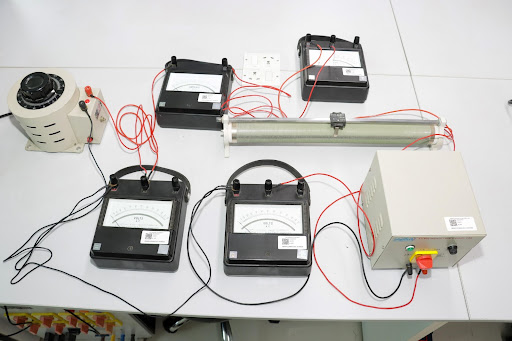
Description
In this experiment, the main aim is to measure three-phase power by two wattmeter method.
Components
- Ammeter (0-10A) MC type (1)
- Voltmeter (0-300V) MC Analog (1)
- Wattmeter (0-600)W (1)
- 3-phase autotransformer (1)
- Load rheostat 10 Amp (1)
Two wattmeter method can be employed to measure the power in a 3 phase, three-wire star or delta connected the balanced or unbalanced load.
In this circuit, the measure of three phase power is used in a star or balanced load.
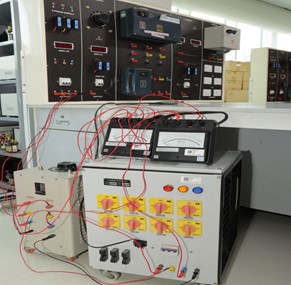
Control Systems Laboratory
Description
I. Compact and user friendly learning platforms to gain invaluable knowledge about order and type of Control System.
II. Square wave, Ramp wave, Parabolic wave, Unit step signal and variable DC supply are provided on board as standard inputs.
III. On board Resistance, Capacitor and Inductor banks for studying different combination for the order of a system are also available.
Experiments:
- To observe the First/Second/Third Order control systems time response.
- To observe the Type-0/Type-1/Type-2 control systems Steady State Error (Ess) for Unit Step/Square wave/Ramp/Parabolic input.
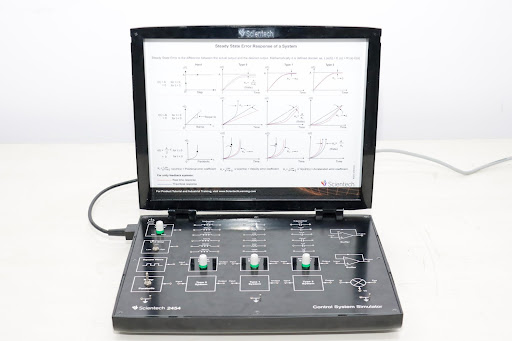
Description
I. Helps the user to gain invaluable practical experience of the principles and application of DC motor position control.
II. Helps in understanding the concept of Robot controls.
Experiments
- To observe the position control system for different values of angular position commands.
- To observe the position control system for different values of the forward gain at different values of angular position commands.
- To observe the controller output of the system for different values of the forward gain.
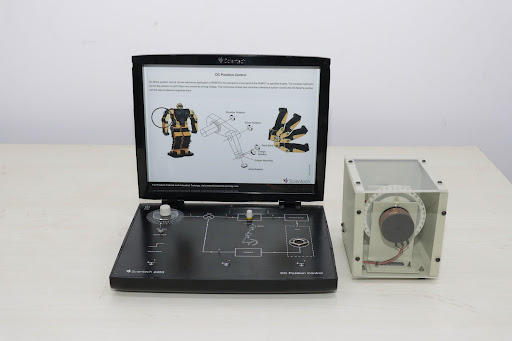
Description
I. Introduce students the operation and control of stepper motor effectively.
II. It helps the student in understanding half and full step angle of stepper motor with visual indication of the coil excitation process.
III. It has a provision for connecting the motor with an external controller designed by students.
Experiments
- Study and use of stepper motor in wobble mode.
- Study of Stepper Motor in Full/Half Step, Single/Two Phase, Free/Step Running Modes.
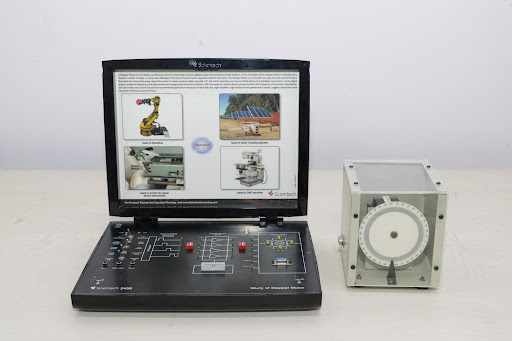
Description
I. Students can study two-position mode as ON/OFF Controller and continuous Controller modes as Proportional (P), Integral (I), Derivative (D), PI, PD and PID control modes.
II. First order system and second order system in open loop and closed loop system.
Experiments
- Study of ON/OFF control.
- Study of P, I, D controls individually.
- Study of PI, PD and PID control modes.
- Study of PID control modes for first order and second order systems.
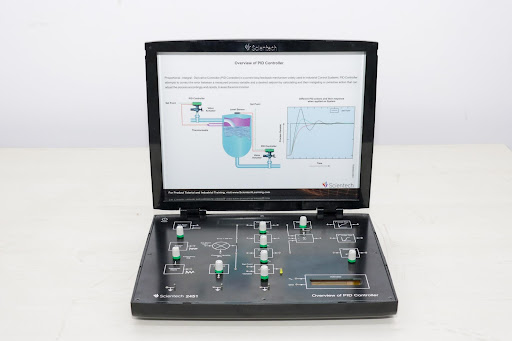
Description
I. Helps the user to gain invaluable practical experience of the principles and application of Leading Lagging of a signal applied to any active network.
II. Helpful to study Lead, Lag and Lag-Lead in the networks as a filter, analysis through Bode plots and compensation of the same.
Experiments
- Study of Lead Compensator.
- Study of Lag Compensator.
- Study of Lag-Lead Compensator.
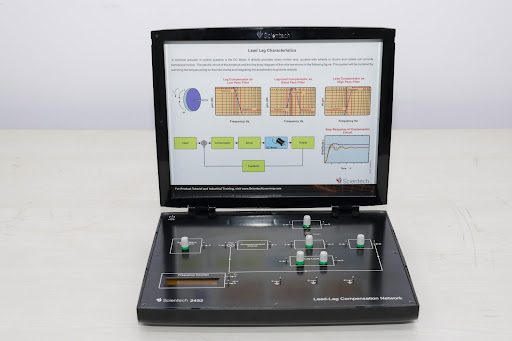
Description
I. Exposes students to the fundamentals of Control System.
II. Studies include how one device can be used manage, command, direct or regulate the behavior of other system Open Loop & Closed Loop Control.
III. Nvis 3000A (as shown in below figure) has various parts like Temperature Sensor, Light Sensor, DC Motor, Servo Motor, LED lamps, IR Sensor, Relay SPST, and Relay DPDT; De-bounce switch, LED Bar, Buzzer etc. which can be used for study of Control system.
IV. Nvis 630 DAQ is very useful for sensing and controlling analog and digital signals of any process.
V. It makes easy and interesting to interface real world signals with PC through USB bus.
Experiments
- To study and observe Voltage to Frequency or Frequency to voltage conversion.
- To study and implement DC Motor Speed Control in Open Loop and Closed loop.
- To study & implement Temperature Control in Open Loop and Closed loop.
- To study & implement Light Intensity Control in Open Loop and Closed loop.
- To study & implement Servo Motor Control.
- To study & implement Home automation.
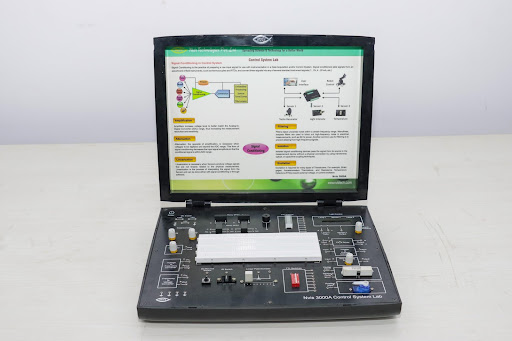
Advanced Control Systems Laboratory
Description
- Developed for project-based learning that combines instrumentation and embedded design with a web-driven experience to create an active learning environment in the lab.
- Delivers a greater understanding of engineering fundamentals and system design.
- Addresses engineering curriculum by integrating project-based learning, teamwork, and design with course-specific application boards and labs developed by experts from education and industry.
- Enables educators to scale to future multidisciplinary applications, driving student employability.
- Used to prototype circuits and systems across a wide variety of disciplines. It features a large central build area, convenient access to the NI ELVIS III control I/O, and integrates a set of commonly used circuit components such as buttons and LEDs to simplify prototyping.

Main Features

1. Analog Input
2. Analog Output
3. Fixed User Power Supplies
4. Digital I/O
5. User peripherals
6. Digital ground
7. Central build area (breadboard)
8. Fixed User Power Supplies LEDs
Description
- Ideal tool to introduce a variety of common actuators and demonstrate their advantages, interfacing and operation, as well as design considerations and limitations.
- The board consists of a brushed DC motor with selectable linear and PWM amplified power amplifiers, a brushless DC motor, stepper motor, integrated servo, and modifiable LabVIEW controllers.
- The board gives the experience with working actuators, while removing the complications involved with wiring and configuring power and control circuitry. Actuator technologies are compared and contrasted, allowing users to become comfortable with making design decisions about actuators and amplifiers in real-world applications.
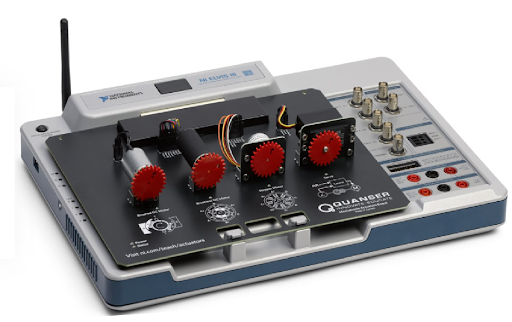
Main Features
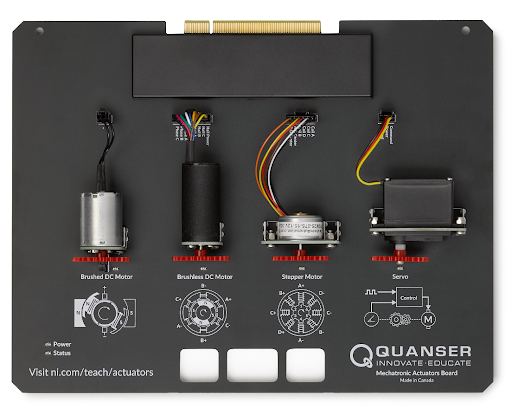
1.Brushed DC motor with 24 pulse/revolution photo microsensor
2.Current sense for brushed DC motor
3.Linear power amplifier
4.PWM power amplifier
5.Brushless DC motor with integrated Hall effect sensors
6.48 step unipolar stepper motor
7.Servo motor
Description
- The Quanser Controls board is a complete platform for investigating almost all aspects of modern control theory from system modelling and PID control to stability and digital control design.
- The system consists of a deterministic DC motor with a high-resolution encoder, as well as a pendulum attachment for balance control.
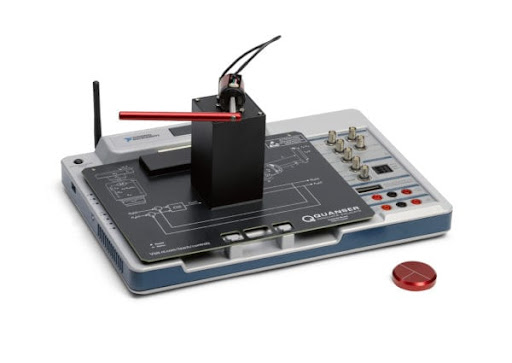
Main Features
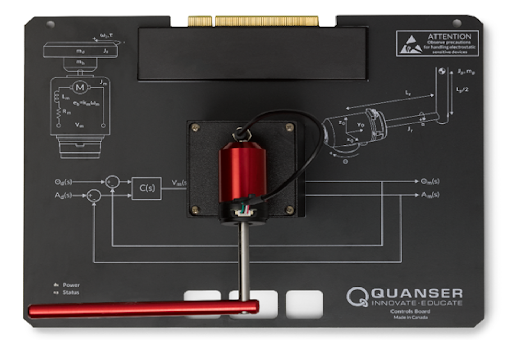
1.Direct-drive brushed DC motor
2.512 count encoder mounted on the motor and on the pendulum arm
3.Built in deterministic PWM amplifier mapped to theoretical motor models
4.DC motor current sense
Description
- The Quanser Energy Systems board is a versatile system designed to allow students to investigate and explore various sub-components of an electromechanical power system. Topic ranges from AC power generation, rectification and inversion to buck and boost DC power conversion.
- The system consists of a DC power source and three phase AC generator, three phase rectifier, switched mode power supply, inverter and transformer, DC current sink, and modifiable LabVIEW controllers.
- The board can be easily adapted to a wide range of energy system applications such as wind and solar power generation as well as consumer power supplies and electric vehicles.
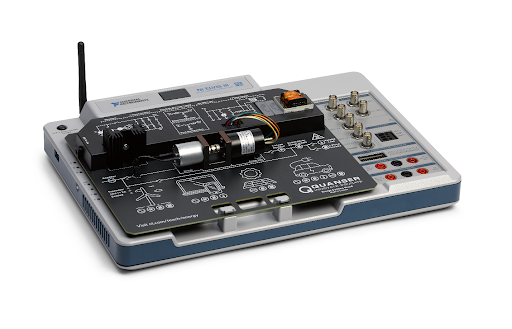
Main Features
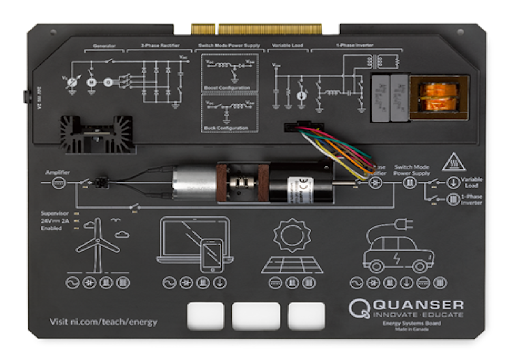
1.Variable linear DC power supply
2.Three-phase AC generator assembly
3.Three-phase rectifier with selectable capacitance
4.Buck and boost switched-mode DC power supply circuits
5.Single phase inverter circuit with transformer and resistive AC load
6.Adjustable DC current sink
Power Systems Laboratory
Description
This setup is designed to study the transmission line parameters (A,B,C,D) of a transmission line model. This set up consists of : AC transmission Line Model, meter set up.
Experiments
- Measurement of Transmission line Parameters (A,B,C,D) of Short Transmission Line Model.
- Measurement of Transmission line Parameters (A,B,C,D) of Medium Transmission Line Model (T, PI& End condenser Network).
- Measurement of Transmission line Parameters (A,B,C,D) of Long Transmission Line Model.
- Study of Ferranti Effect of Transmission Line Model.

Description
This Dc distribution system Trainer is specially designed to study the various type of dc distribution network system.
Experiments
Study of Radial Distribution network.
- Distribution system fed at one end
- Distribution system fed at both end
- Distribution system fed at centre
Study of Ring Main Distribution network.
Study of Inter Connected system.

Description
This set up is designed to study the measurement procedure of Sequence impedance (Positive, negative, Zero), and study the measurement of fault current by simulating various types of faults (LG,LL,LLG,LLLG etc.) under low field voltage.
Experiments
Measurement of Sequence Impedance of Alternator.
Measurement of Synchronous Impedance of Alternator.
Measurement of Fault Current for various types of faults (LG,LL,LLG,LLLG etc.).

Description
This set up is designed to study the measurement of Power angle of an alternator. This set up consists of 3 Phase Alternator with prime mover set up & Control Panel with Fault simulation switches.
Experiments
Measurement of POWER ANGLE characteristics of alternator with infinite bus bar.

Description
This trainer set up is designed to study the measurement procedure of ‘Positive , Negative & Zero sequence impedance’ of 3phase transformer and study the measurement of fault current by simulating various types of faults (LG,LL,LLG,LLLG etc.)under low field voltage.
Experiments
Measurement of Sequence Impedance of transformer.
Measurement of Fault Current for various types of faults (LG,LL,LLG,LLLG etc.).

Description
This trainer set up is designed to study the measurement procedure of ‘Positive , Negative & Zero sequence impedance’ of 3phase transmission line and study the measurement of fault current by simulating various types of faults (LG,LL,LLG,LLLG etc.)under low field voltage.
Experiments
Measurement of Sequence Impedance of transmission lines.
Measurement of Fault Current for various types of faults (LG,LL,LLG,LLLG etc.).
Study of Relay Operation.

Power Electronics Laboratory
Description
This trainer is designed to study the V-I characteristics (STATIC characteristics) of SCR, TRIAC, MOSFET and IGBT. This trainer consists one number of SCR(TYN 612), TRAIC(BTA12), MOSFET(IRF840) and IGBT(IRGBS30S) with heat sinks.
Experiments
- Study of V I Characteristics of SCR.
- Study of V I Characteristics of TRAIC.
- Study of Drain and Transfer Characteristics of MOSFET.
- Study of Drain And Transfer Characteristics of IGBT.

Description
This power module is designed to study the single phase half & fully controlled bridge converter with R, RL and RLE LOAD. This module is designed by using SCR & DIODE for AC-DC Controlled Converter applications. This power module can be used for DC Motor open loop & closed loop speed control application .
Experiments

Description
This module is designed to study the 3 phase half & fully controlled converter with R, RL and RLE LOAD, Ac Voltage regulator power circuit. This power module can also be used for DC Motor open loop & closed loop speed control application.
Experiments

Description
This set up is designed to study the BUCK switch mode converter circuits. This set up consists of PWM Controller, MOSFET Power circuit & DC Power supply.
Experiments
Study of DC-DC Buck Converter.
- Open Loop Control
- Closed Loop Control

Description
This set up is designed to study the BOOST switch mode converter circuits. This set up consists of PWM Controller, MOSFET Power circuit & DC Power supply.
Experiments
Study of DC-DC Boost Converter.
- Open Loop Control
- Closed Loop Control

Description
This module is designed to study the single phase dual converter with R, RL loads. This module is designed by using SCRs for combination of rectifier (AC to DC) and inverter (DC to AC) applications.
Experiments
Study of Single phase fully controlled full bridge converter with R & RL loads.

Description
This trainer is designed to study the working of IGBT based DC-AC inverter ( single phase & 3 phase) using various PWM techniques. It consists of IGBT PWM Controller & 3 Phase IGBT Power Circuit, RL Load & DC Power supply.
Experiments
- Study of uni-polar and bi-polar PWM based single –phase inverter.
- Study of single phase square PWM inverter
( Multi pulse inverter) with R load. - Study of single phase sine PWM inverter
( SPWM inverter) with R load. - Study of Three phase SINE PWM inverter with R load.

Description
This trainer is designed to study the working of IGBT based DC-AC inverter ( single phase & 3 phase) using various PWM techniques. It consists of IGBT PWM Controller & 3 Phase IGBT Power Circuit, RL Load & DC Power supply.
Experiments
Study of 3-phase PWM & non PWM Inverter.
Study of PMDC back to back coupled motor control.
Study of Speed Control (Open Loop/Closed Loop) of PMDC Motor using IGBT Chopper.
Study of Four quadrant operation of dc motor using IGBT Chopper.

Description
This setup designed to study the working principle of single-phase step-down cyclo-converter (Mid Point type). This setup consists of Single phase cyclo converter firing circuit and SCR power circuit.
Experiments
Study of Single Phase step-down midpoint type cycloconverter.


